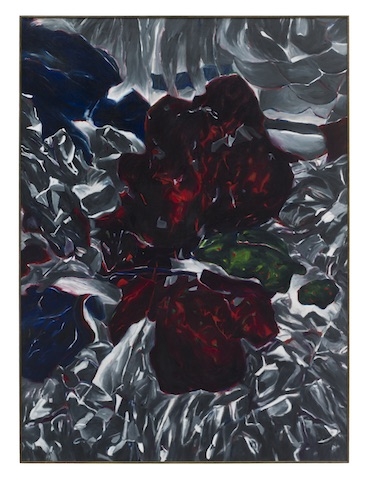Two years ago, Kimmerich staged the first solo exhibition in Germany of American painter Deborah Remington (1930–2010), showcasing 16 works from 1972 to 82. Now, the Berlin gallery presents another deceptively modest showing: eight oil paintings, completed between 1991 and 2003. Each one measures 163 x 119 cm and bears Remington’s hallmarks: her preferred portrait format, her signature restricted palette of black and white, yellow, red and blue. Nevertheless, Remington always said that ‘if the vision changes, then the technique should change’. The vision, towards the end of her life, was very much changed by invasive treatments for lung cancer, depression over waning sales and recognition, and then the catastrophic attacks of 9/11, which were made all the more palpable as a thick layer of toxic dust settled over her Lower Manhattan apartment. What is astonishing is that this period arguably hailed some of Remington’s most vigorous painting.
Remington had always sought what she called ‘equilibrium through dis-equilibrium’ in her art. The abstract works of the 1960s to 80s, for which she is best known, frequently depict empty reflective surfaces, eerily backlit and suspended in space, like machine-made Rorschach blots or warped heraldic motifs. Her art defies clichés of ‘feminine’ aesthetics, and is fascinating to view in the knowledge that it was made by a so-called difficult woman (as gossip would have it) in twentieth-century America. Remington had studied at the California School of Fine Arts – now the San Francisco Art Institute – in the 1950s. She was the only female cofounder of the legendary Six Gallery, whose other founders included Jack Spicer and Hayward King, and where, in 1955, Beat poet Allen Ginsberg first read his landmark ‘Howl’. A photograph from the time shows the founders standing in a queue. Remington, at the front in paint-splattered jeans, has about-turned to face the men she considered her equals. Their expressions betray the playfulness of the confrontation, but her expression is deadly serious. ‘Beats don’t smile’, she is quoted as once saying by writer Frank Beacham.
The ‘dis-equilibrium’ for which Remington had such an affinity was clearly taking a personal toll by the 1990s. The late paintings are testament to a sustained, deeply contemplative practice that could overcome physical suffering and harness her fears into art. Where earlier work possessed a contained theatricality, the drama here is intense. Elements haemorrhage across the canvas. The deco-like veneer of the 1960s–70s canvases is only barely there, with something akin to a Chaim Soutine carcass cracking through the paint. Here, Remington’s loosened technique also suggests her work being haunted by much earlier visions: namely, her beginnings in Abstract Expressionism.
Remington’s paintings always have intriguing titles, often as abstruse as their imagery; Mechelen (1989–91), named for a historic Belgian city that was also a centre of deportation to Auschwitz, visually suggests a flower. Its dark reds evoke velvety petals, set off against a leaf of green and shards of white, a bloom trampled into glass. As dissimilar as it seems, this painting, alongside Quanta (1991), recalls something of the small, final flower paintings of the dying Édouard Manet. Occupying the back wall of the gallery (so that it is likely to be the last encountered) is Calyd (1999–2003), named after a plant in the funereal lily family. Reworked like other paintings over a number of years, it is the only work here that crosses into the post-9/11 era and, uniquely, revives the more hard-edged style of Remington’s better known period. A deep-space darkness seems to have been blasted from behind, revealing an icy infinity that is also strangely glimpsable in the foregrounded shards of the exploded ‘fourth wall’.
Style and fashion have seen an explosion of 1990s nostalgia in recent years, mainly enjoyed by those too young to remember. There often seems to be a collective longing for what we imagine the decade was: pre-9/11, pre-President Trump, pre-Big Data, etc. It must be with some knowingness of this cultural mood, then, that Kimmerich titled this exhibition, and presented the formidable Deborah Remington as a response.
Deborah Remington: The 90s at Kimmerich, Berlin, 27 February – 14 April
From the May 2018 issue of ArtReview
